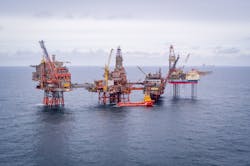Offshore staff
LYSAKER, Norway – Aker BP has completed plugging of wells at the Valhall field center in the southern Norwegian North Sea, six years ahead of its original schedule.
The program is an important part of the modernization of the field center, as the company and partner Pandion aim to produce a further 1 Bboe from Valhall and sustain operations through 2050.
First oil flowed from the field in 1982, and more than 1 Bboe have been produced from the area to date, more than three times as much as expected at start-up.
Valhall Asset Manager Ole Johan Molvig said: “We will maximize value creation from the area through new wells, flank developments, and new technology.”
Last week the jackup Maersk Invincible departed the field, with 30 old wells from the original drilling platform (DP) having been plugged during three campaigns since 2014.
The first was conducted in 2014-2016 by the Maersk Reacher, with the Maersk Invincible managing the last two campaigns in 2017-2018 and in 2020-2021.
According to Aker BP, the final cost of the campaigns was NOK10.1 billion ($1.22 billion), much lower than the original estimate of NOK15.5 billion ($1.87 billion).
The jackup rig alliance between Maersk Drilling, Halliburton, and Aker BP executed the final work program from September to March.
Although the original plan had been to spend 72 hours per well to plug the top well section, this winter the alliance cut the duration to 33 hours, also delivering the full work scope more than two months ahead of schedule.
That in turn allowed the Valhall asset team to mature a decision on new wells on Valhall Flank North, which the alliance will also undertake.
Aker BP has sanctioned various new technologies for the plugging campaign. Martin Straume, the company’s chief engineer for well P&A work, said: “We have looked at technology that can contribute to faster, safer and more sustainable plugging of wells.
“The drivers behind this development have been engineers who have seen a need, found a technology, and contributed to develop it. The road from concept to implementation has been consistently short.”
Where feasible, the alliance has implemented technology used for well intervention, including a ‘shale barrier.’
“Section milling of cemented casing has been carried out inside larger casing,” Straume explained. “We have done this to verify that well barriers are in place on the outside of the conductor.
“This means that we have avoided having to mill or pull entire sections of casing from the surface and down to the relevant depth. This represents up to several weeks of time saved per well, and is an enormous improvement in the plugging work.”
The top section of the old Valhall wells have been plugged using bismuth technology developed by BiSN to address potential methane leaks from old wells, an approach said to result in lower CO2 emissions compared with cement.
And for the first time, Aker BP, working alongside Halliburton and Maersk Drilling, has performed fully automated cementing operations from shore, in this case at Aker BP’s offices in Stavanger.
Results are said to include increased efficiency, reduced costs, and lowered HSE risk.
Just over a year ago first oil flowed from the Valhall Flank West development and a new platform for the satellite Hod field is nearing completion at Aker Solutions’ yard in Verdal, Norway.
The concept, implementation model, and organization for the Hod project replicated the set-up at Valhall Flank West. The new platform should start operating in 1Q 2022, and will recover estimated reserves of around 40 MMboe.
Aker BP has now started studies for a new central platform on Valhall, to ensure production capacity for future volumes in the area.
04/20/2021



